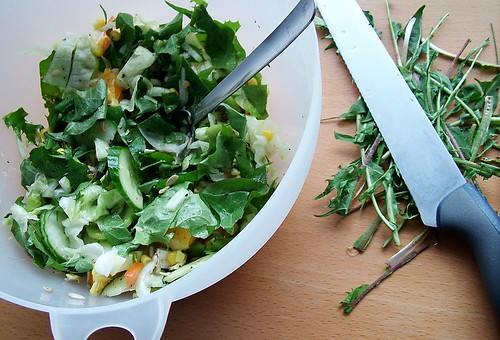Eat up Nature

I waited two weeks because I wanted to test how the effect on me was. No negative progressions. My organism stayed stable. Or at least as stable as I know it.
Today I have picked again dandelion* and tore it into pieces before I washed it. It tastes a little bitter. Therefore I decided to combine it with diced onions and tomatoes, iceberg lettuce, sliced kiwi, pieces of orange and feta dices. I added black pepper, salt and some vegetarian bouillon powder. I was in a scrape and had to take the latter because Denmark's supermarkets are badly equipped with industrial salad dressing. Furthermore: sunflower seeds plus salad oil and vinegar.
In the end I am very pleased with the result of my endeavours: a composition that provides my tongue with the most incredible adventure, a journey from undisturbed fields and forests of mother nature to the virtuosity of human food chemists and their magic greenhouses and field tests. Garnished with the innovative spirit of my mind.
Generally, I love organic food picked next to my frontdoor. My maternal grandmother always picked stinging nettles in front of her door to prepare them as spinach for my grandfather, maybe because it was healthier in view of his diabetes. And it was my grandmother who showed me that I can eat common sorrel** from the willow of my parents' house. It were the neighbour's child and my brother who told me that I can eat a green plant with white blossoms which sprouted sporadic near to our play area. It was me who survived it just as the water I drank which came out of a pipe leading in the canal in front of our house.
This experience made me more courageous: I started to eat daisies***, pieces of grass, blossoms of buttercups. The ant — I gulped it only because it as object of a bet. The earthworms — I never really ate them, neither the spiders.
That reminds me of peoples that dine insects without any reluctance. A earthworm is admittedly no insect, more an annelid (by the way: here a picture of a mating couple) and surely an articulate animal (Articulata) as well as an ant (here it is milking a greenfly) or spiders. I recall that my chinese neighbour told me that inhabitants of his country let vanish scorpions in their mouth. Once he let disappear a part of a crocodile that tastes like chicken (or dog — I can't remember). I personally don't know what Native Americans ate apart from buffaloes, maybe once in a while accidentally midges. What I know is that their offspring partly pays no tax in Canada.
This detection leads me to my grandfather's overdelivery that he was a chieftain when he was younger. Therefore I always placed his past life in America, in the community of the indigenous people in question. Later I got aware that my grandfather actually alluded to his surname which refers to the tradition of an old East Frisian dynasty. Possibly it is unworthy for a descendent of the nobility to eat crawling or sprouting parts from outside. On the other hand nobody ever cleared up me about what a aristocrat must eat or not. Potentially, in decent times it was not goose liver but insects as part of the order of courses. I even heard about people eating pieces of amphibians and pull snails out off their houses to consume them. Presumably, the punishment is that they aren't successful in trans-European music contests.
* In German of course "Löwenzahn". And there is another term for it that I nearly forgot: "Kuhblume". On the background of my experiences I would have called it "Kaninchenblume" or "Meerschweinchenblume" since I know for sure that the rabbits that my siblings and I once had surely ate dandelion. And Pelle, my Angora guinea pig, was also fond of eat. He is dead now.
** In Latin Rumex acetosa, German: Wiesensauerampfer.
*** I just have decided not to translate any words in this article any more. You know that "daisies" don't refer to a multiplicity of Donald Duck's girl-friends, do you? Not? Look here.


Keine Kommentare:
Kommentar veröffentlichen